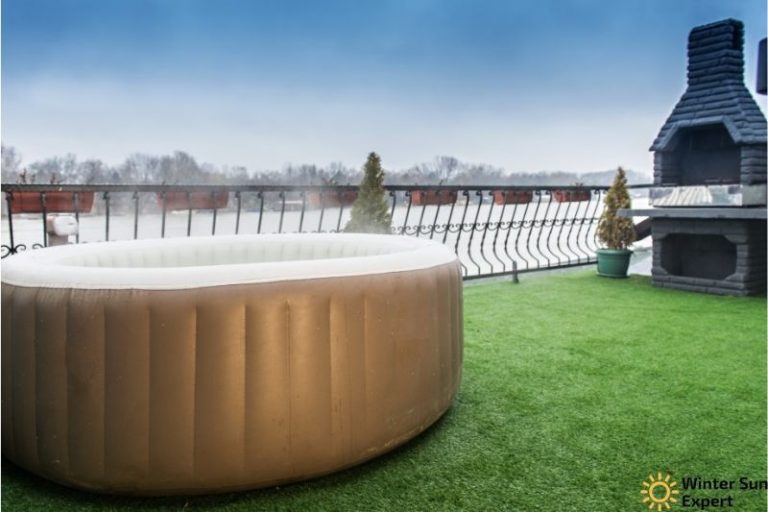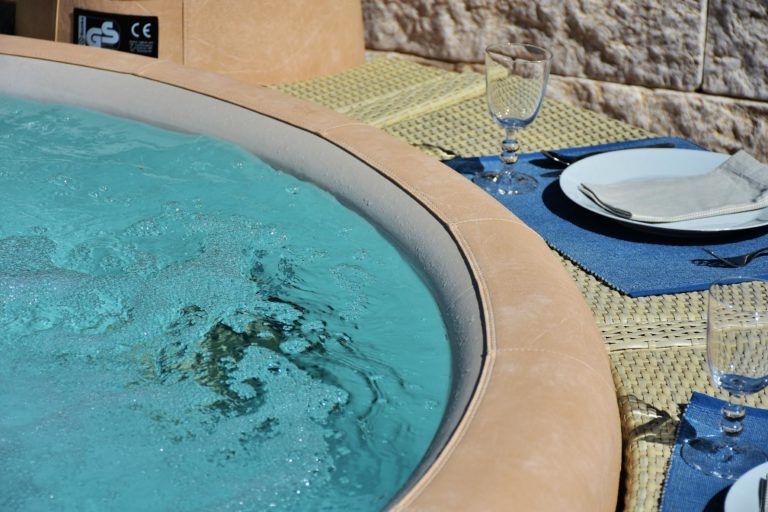Are algae in hot tub dangerous?
Hot tubs and pools can be a great way to spend some time with friends and loved ones. They also provide tons of benefits, such as reducing stress and making memories. But what should you do when your hot tub gets dirty with algae?
Are algae in hot tub dangerous:
In general, the presence of algae in the hot tub water shows that the water quality is poor. It can cause health issues if you do not clean the water. There are different types of algae, like green algae, mustard algae, black algae, pink algae, and white mold. It should be seen as a signal to improve your maintenance in almost all cases.

I will explain in more detail the different kinds of algae that can infect your hot tub water, and what to do. Also, what causes algae in your hot tub, and how you can kill them.
Contents
Are algae in hot tub dangerous?
There are different types of algae that you can find in your hot tub. How do you know what you see in your hot tub? Some are harmless, and some are more harmful:
– Hot tub Water: Green Algae:
Green algae need not directly cause you any disease or discomfort. Still, its occurrence in the hot tub water indicates that the water quality is not maintained correctly, leading to other bacterial growth, which can be dangerous.
When the sanitizer levels in the water are not good enough, it leads to the growth of green algae in the water. Apart from causing the hot tub water to be cloudy, the green algae may make the shell of your hot tub slimy or sticky. The presence of green algae may also lead to bacteria like Pseudomonas aeruginosa, which causes hot tub rash or other health issues.
– Hot tub Water: Mustard algae:
If you have sheets of yellow or brownish spots in your hot tub, it could be a case of mustard algae growing in the tub water. It can well sustain in hot water if the sanitizer levels are poorly maintained. They can also grow in the innards or small cracks in the hot tub, later multiplying and spreading to others parts of the tub.
I recommend getting it removed before using a hot tub infected with mustard algae. Mustard algae, once infected, can get reintroduced into the hot tub in many ways despite removal. Its small traces on accessories you use for hot tub maintenance like vacuums or brushes may bring them back into the hot tub water.
– Hot tub Water: Black algae:
When you spot black, sticky patches on the bottom of the hot tub or in other hot tub parts, it indicates black algal growth. The presence of black algae in the hot tub water is a sign of danger as it is caused by insufficient levels of Chlorine or Bromine in the water.
This can be caused by poorly functioning hot tub filters. Check the hot tub filter, and clean or replace it when needed.
– Hot tub water: White mold:
Though not an alga, the presence of white mold may be spotted in poorly attended hot tubs. These are bacterial growth which shows up as white clumps of foreign particles in the hot tub water. It is dangerous to use hot tub water with white mold growth.
– Hot tub Water: Pink algae:
Technically, these are no algae but bacterial growth, dangerous for hot tub users. Particularly if the infection has turned the hot tub water to look pink. This micro-organism forms small clusters of pinkish colonies. Only mature colonies spread across the hot tub to make the water pink. It is important to shock the hot tub water and use a purging agent to clean all the bacterial and algal growth before using the hot tub in such conditions.
Is it safe to get in a green hot tub?
It is not safe to get into a hot tub if the water is greenish and cloudy. Algal growth in the hot tub water may lead to green hot tub water. It indicates the absence of enough sanitizer content in the water. The lack of sanitizer in the hot tub water could lead to other germs like Legionella. Legionella can infest poorly sanitized hot tub water and can cause severe pneumonia to bathers if they breathe in the bacteria along with the steam from the hot tub.
It is also possible that something else may lead to the green color of the hot tub water. The presence of metal content in the hot tub water may lead to the water getting a green tint. In such cases, it may be just a tint, and greenish particles may not be visible in the water.
But to be sure, I always recommend not using the hot tub when you find the water to be green. First, check what the cause is. If your maintenance is indeed lacking, first improve it. Maybe it is time to replace the water and maintain your hot tub regularly.
What kills algae in hot tubs?
Shock is an effective way to kill algal growth in hot tub water. Use a super-chlorinating agent to shock the tub water to raise the Chlorine presence in the tub water to 30 ppm. Ensure that the water in the hot tub circulates well so that the sanitizer can kill algal traces in the cracks and crevices of the hot tub parts.
In the case of milder algal growth at the initial stages, it can be killed by using algaecide agents. Also, ensure to deep clean the hot tub filters after aftershock to remove any algal spores trapped in the filters.
In case of wide-spread algal growth in the hot tub, you need to scrub it off the hot tub surface and remove the debris using a vacuum. To kill all algal growth in a hot tub, it is also essential to keep other hot tub items like vacuums, skimmers, brushes, and rugs sanitized. Traces of algal spores in these accessories also may reintroduce the algae into the hot tub water after a cleaning cycle. So ensure to clean the accessories before using them.
I recommend purging the hot tub using a flush clean agent like Aah-some if the algal colonies are deep-rooted. It is better to drain and refill the hot tub after the purge in such cases. Purge and drain also help kill any bacterial colonies that have flourished along with the algae in the hot tub parts.
The following treatments are suitable methods to prevent algal growth in the hot tub water:
– Maintaining the pH balance of the hot tub water
It is essential to maintain the pH levels of the hot tub water between 7.2 to 7.5. It prevents algal and bacterial growth. As such, this pH range does not necessarily kill the algae on its own. But it ensures that the sanitizers in the water function effectively. The sanitizer in the hot tub water is not effective in low pH or alkalinity cases.
– Ensure adequate sanitizer presence in the water
Since a pH range that facilitates sanitizer action is maintained, ensure enough sanitizer in the hot tub water. In the case of hot tubs which follow the Chlorine route, toss in Chlorine granules after each use to keep the sanitizer levels of the water around 4 ppm. If it is a Bromine-based system, ensure to have around 3 ppm Bromine presence in the hot tub water.
– Test and maintain total alkalinity
To keep away algal growth, the total alkalinity of the hot tub water should be around 110 to 140 ppm range. However, the ideal value for total alkalinity would be 125 ppm. Keeping the hot tub water properly maintained would kill any algal growth in the tub.
What causes algae in hot tubs?
There are several reasons which contribute to algal growth in hot tubs. In the case of outdoor hot tubs, algal growth can happen if you keep the hot tub open for a very long time during the day. Exposure to sunlight aids algal growth, especially if you are lazy about adding the daily sanitizer dose to the pool.
I recommend keeping the tub closed when you are not using it. Apart from algal growth, it will block contaminants and debris from getting into the hot tub, and you will save on heating costs.
The primary reason for algal growth in the hot tub water is the absence of sanitizer levels in the water and poor water chemistry. When the levels of oxidizing agents like Chlorine in the water plummets, it leads to the growth of algae and other contaminants like bacteria.
When the hot tub water is not well maintained within the accepted range of total alkalinity, it can also lead to algal growth in the hot tub water. When the pH level of the hot tub water is not maintained within the 7.2 – 7.5 range, it will eventually cause algal growth.
If your hot tub filters are not in good condition, it will also lead to poor water quality and algal growth. You need to clean the hot tub filters at least twice a week and replace them annually to prevent algal growth and bacterial growth in the hot tub water.
The following table details the type of algal growth and remedies
Type of Algal growth | Visual appearance | Danger level | Removal steps |
|---|---|---|---|
Green Algae | Tub water turns green with or without green clumps floating in the water | Not very dangerous, but do not soak in the water | – Shock the tub – Scrub off any slimy growth – Drain and refill if it does not clear up in 24 hours |
Mustard algae | Yellow or brownish spots in the tub | Dangerous. Do not soak in the water | – Scrub off the spots in the tub – Shock the tub – Add Algaecide – Circulate the water – Drain and refill |
Black Algae | Black, sticky patches in the bottom or sides of the hot tub | Dangerous. Do not soak in the water | – Scrub off the spots in the tub – Shock the tub – Add Algaecide – Purge and refill if the spots come back within days |
White mold | White clumps in the water or on hot tub parts | Dangerous fungal growth. Don’t soak in the water | – Scrub off – Ensure the filters are clean and functional – Maintain the total alkalinity and pH balance of the water at recommended levels |
Why do I ache after hot tub?
Some users may feel minimal and temporary body ache after prolonged soaking in the hot tub water. There is nothing to worry about. Hot water typically loosens up the muscle tissue, and when you are out of hot water, some muscle tissue may stiffen up, leading to very minimal muscle soreness. This condition is very temporary and shall not sustain.
However, if the hot tub water you were soaking in was contaminated, it can lead to a condition known as hot tub rash, in which you may develop itchy rashes. The condition will most likely subside after some days if you stop soaking in the contaminated hot tub water. However, it is advised to take medical help if the itching, rashes, or body ache sustains for days.






